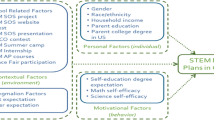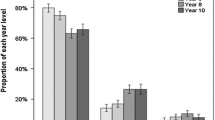Abstract
Research on college choices is the new tool used by Higher Educational Institutions to help them identify the influences and factors affecting potential student populations. To measure the growing rate of working students in higher education, we propose to examine the decisions made after graduating from high school to current demographic changes. In this study, we use data from the Educational Longitudinal Study of 2002 (ELS: 2002) to estimate the influence of individual variables on post graduating high school choices using multinomial logistic regression analysis. Untangling the individual choices allows us to examine, four possible after high school life choices—students who decide to pursue post-secondary education (student); those who decide to work while attending a post-secondary institution (working student); those who decide to enter the workforce (worker) or high school graduates who neither work nor enroll in postsecondary education (unemployed). Results suggest that aside from socioeconomic status and achievement, interesting patterns for gender, ethnicity and family composition and its effect on the likelihood of a high school graduate’s life choices emerged. As an example, Asian students are more likely to enter their next phase in life as a student than a working student in comparison to white ones. That result is a clear example that not all high school students are alike in their life choices; therefore, for a better understanding in the needs and decision making ways of high school graduates, this paper addresses different factors that lead to a post-secondary decision in order to accommodate their transition to HEI.
Similar content being viewed by others
Notes
The phrase “college selectivity” is typically used in the United States in reference to the ratio between students who applied to those who are accepted into any HEI.
We acknowledge that the term “college” can have several meanings depending on context and this liberal use of this language is commonplace in the American experience; however, in this manuscript, “college” will refer to all forms of higher education including two-/four-year institutions and both public and private institutions. Also, “college” throughout this manuscript is also considered synonymous with the term “post-secondary”, “higher education” and “tertiary” used.
References
Ainley, J., Foreman, J., & Sheret, M. (1991). High school factors that influence students to remain in school. The Journal of Educational Research, 85(2), 69–80.
Anderson, K. L. (1981). Post-high school experiences and college attrition. Sociology of Education, 54(1), 1–15.
Avery, C., & Kane, T. (2004). Student Perceptions of College Opportunities. The Boston COACH Program. In C. Hoxby (Ed.), College choices: The economics of where to go when to go, and how to pay for it. National Bureau of Economic Research. Chicago: University of Chicago Press.
Barone, F. J. (1993). The effects of part-time employment on academic performance. NASSP Bulletin, 77, 67–73. doi:10.1177/019263659307754910.
Beattie, I. R. (2002). Are all ‘Adolescent Econometricians’ created equal? Racial, class, and gender differences in college enrollment. Sociology of Education, 75(1), 19–43.
Bozick, R. (2007). Making it through the first year of college: The role of students’ economic resources, employment, and living arrangements. Sociology of Education, 80(3), 261–285.
Brewer, D., Eide, E., & Ehrenberg, R. (1999). ‘Does it pay to attend an elite college? Cross cohort evidence on the effects of college type on earnings. Journal of Human Resources, 34, 104–123.
Bureau Labor of Statistics. (2010). College enrollment and work activity of 2009: High school graduates. News Release. U.S. Census Bureau. Accessed 2 February 2011.
Cabrera, A., & La Nasa, S. (2000). Understanding the college-choice process. New Directions for Institutional Research, 107, 5–22.
Chapman, D. W. (1981). A model of student college choice. The Journal of Higher Education, 52(5), 490–505.
Cheng, D. X., & Alcántara, L. (2007). Assessing working students’ college experiences: A grounded theory approach. Assessment & Evaluation in Higher Education, 32(3), 301–311. doi:10.1080/02602930600896639.
Coleman, J. S. (1988). Social capital in the creation of human capital. The American Journal of Sociology, 94, S95–S120.
Davies, S., & Guppy, N. (1997). Fields of study, college selectivity, and student inequalities in higher education. Social Forces, 75, 1417–1438.
Dundes, L., & Marx, J. (2006–2007). Balancing work and academics in college: Why do students working 10 to 19 hours per week excel? Journal of College Student Retention, 8(1), 107–120.
Dynarski, S. (2003). Does aid matter? Measuring the effect of student aid on college attendance and completion. The American Economic Review, 93(1), 279–288.
Ehrenberg, R. G., & Sherman, D. R. (1981). Employment while in college, academic achievement, and postcollege outcomes: A summary of results. The Journal of Human Resources, 22(1), 1–23.
Evans, W., & Schwab, R. (1995). Finishing high school and starting college: Do catholic schools make a difference? The Quarterly Journal of Economics, 110(4), 941–974.
Flint, T. A. (1992). Parental and planning influences on the formation of student college choice sets. Research in Higher Education, 33(6), 689–708.
Gonzalez, K., Stoner, C., & Jovel, J. E. (2003). Examining the role of social capital in access to college for Latinas: Toward a college opportunity framework. Journal of Hispanic Higher Education, 2, 146–170.
Harackiewicz, J. M., Barron, K. E., Tauer, J. M., & Elliot, A. J. (2002). Predicting success in college: A longitudinal study of achievement goals and ability measures as predictors of interest and performance from freshman year through graduation. Journal of Educational Psychology, 94, 562–575.
Hill, D. (2008). School strategies and the ‘College-Linking’ process: Reconsidering the effects of high schools on college enrollment. Sociology of Education, 81(1), 53–76.
Kao, G., & Thompson, J. S. (2003). Racial and ethnic stratification in educational achievement and attainment. Annual Review of Sociology, 29, 417–442.
Kim, J., DesJardins, S. L., & McCall, B. P. (2009). Exploring the effects of student expectations about financial aid on postsecondary choice: A focus on income and racial/ethnic differences. Research in Higher Education, 50, 741–774. doi:10.1007/s11162-009-9143-x.
Kim, D. H., & Schneider, B. (2005). Social capital in action: Alignment of parental support in adolescents’ transition to postsecondary education. Social Forces, 84(2), 1181–1206.
Klem, A., & Connell, J. (2004). Relationships matter: Linking teacher support to student engagement and achievement. The Journal of School Health, 74(7), 262–273.
Lillydahl, J. (1990). Academic achievement and part-time employment of high school students. The Journal of Economic Education, 21(3), 307–316.
Manski, E. E., & Wise, D. A. (1983). College choice in America. Cambridge, MA: Harvard University Press.
Marsh, H. (1991). Employment during high school: Character building or a subversion of academic goals? Sociology of Education, 64(3), 172–189.
McLanahan, S. S., & Sandefur, G. (1994). Growing up with a single parent: What hurts, what helps?. Cambridge, MA: Harvard University Press.
Melguizo, T. (2008). Quality matters: Assessing the impact of selective institutions on minority college completion rates. Research in Higher Education, 49(3), 214–236.
Moore, R., Studenmund, A. H., & Slobko, T. (1991). The effect of the financial aid package on the choice of a selective college. Economics of Education Review, 10(4), 311–321.
Perez, P., & McDonough, P. (2008). Understanding Latina and Latino college choice: A social capital and chain migration analysis. Journal of Hispanic Higher Education, 7, 249–266.
Perna, L. W. (2010). Understanding the working college student. Academe, 96(4). Accessed from: http://www.aaup.org/AAUP/pubsres/academe/2010/JA/feat/pern.htm.
Perna, L. W., & Titus, M. (2005). The relationship between parental involvement as social capital and college enrollment: An examination of racial/ethnic group differences. The Journal of Higher Education, 76(5), 485–518.
Plank, S., & Jordan, W. (2001). Effects of information, guidance, and actions on postsecondary destinations: A study of talent loss. American Educational Research Journal, 38(4), 947–979.
Planty, M., Hussar, W., Snyder, T., Kena, G., KewalRamani, A., Kemp, J., et al. (2009). Condition of education 2009 (NCES 2009-081). National Center for Education Statistics, Institute of Educational Sciences, U.S. Department of Education. Washington, DC.
Quirk, K. J., Keith, T. Z., & Quirk, J. T. (2001). Employment during high school and student achievement: Longitudinal analysis of national data. Journal of Educational Research, 95(1), 4–10. doi:10.1080/00220670109598778.
Riggert, S. C., Boyle, M., Petrosko, J. M., Ash, D., & Rude-Parkins, C. (2006). Student employment and higher education: Empiricism and contradiction. Review of Educational Research, 76, 63–92. doi:10.3102/00346543076001063.
Sandefur, G. D., Meier, A. M., & Campbell, M. E. (2006). Family resources, social capital, and college attendance. Social Science Research, 35, 525–553.
Saunders, M., & Serna, I. (2004). Making college happen: The college experiences of first generation Latino students. Journal of Hispanic Higher Education, 3(2), 146–163.
Sewell, W., & Shah, V. (1968). Social class, parental encouragement, and educational aspirations. The American Journal of Sociology, 73(5), 559–572. doi:10.1016/j.ssresearch.2004.11.003.
St. John, E. P., Paulsen, M. B., & Carter, D. F. (2005). Diversity, college costs, and postsecondary opportunity: An examination of the financial nexus between college choice and persistence for African Americans and Whites. The Journal of Higher Education, 76(5), 545–569.
Stanton-Salazar, Ricardo. D. (1997). A social capital framework for understanding the socialization of racial minority children and youths. Harvard Educational Review, 67, 1–40.
Stern, D., & Briggs, D. (2001). Does paid employment help or hinder performance in secondary school? Insights from US high school students. Journal of Education and Work, 14(3), 355–372. doi:10.1080/13639080120086148.
Stern, D., & Nakata, Y. (1991). Paid employment among U.S. college students: Trends, effects, and possible causes. The Journal of Higher Education, 62(1), 25–43.
Stordahl, K. (1970). Student perceptions of influences on college choice. The Journal of Educational Research, 63(5), 209–212.
Stratton, L. S., O’Toole, D. M., & Wetzel, J. N. (2008). A multinomial logit model of college Stopout and Dropout behavior. Economics of Education Review, 27, 319–331. doi:10.1016/j.econedurev.2007.04.003.
Tierney, M. (1983). Student college choice sets: Toward an empirical characterization. Research in Higher Education, 18(3), 271–284.
Warren, J. R. (2000). Reconsidering the relationship between student employment and academic outcomes: A new theory and better data. Youth & Society, 33, 366–393.
Warren, J. R., & Cataldi, E. F. (2006). a historical perspective on high school students’ paid employment and its association with high school dropout. Sociological Forum, 21(1), 113–143.
Wojtkiewicz, R. A., & Holtzman, M. (2011). Family structure and college graduation: Is the stepparent effect more negative than the single parent effect? Sociological Spectrum, 31(4), 498–521.
Author information
Authors and Affiliations
Corresponding author
Rights and permissions
About this article
Cite this article
Lee, K.A., Leon Jara Almonte, J. & Youn, MJ. What to do next: an exploratory study of the post-secondary decisions of American students. High Educ 66, 1–16 (2013). https://doi.org/10.1007/s10734-012-9576-6
Published:
Issue Date:
DOI: https://doi.org/10.1007/s10734-012-9576-6




